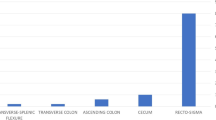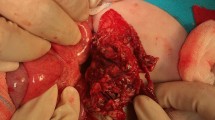Abstract
Purpose
Although recent reports have seen an increase in acceptance of laparoscopic surgery as treatment for traumatic colon injury, its role in the management of non-traumatic colon perforation in children has not been reported. In this study, we review our experience in laparoscopic non-resectional management for children who presented with non-traumatic colonic perforation.
Methods
Between October 2003 and May 2011, 15 children who had been diagnosed with colonic perforation and underwent laparoscopic surgery were included in the study. Their medical records were reviewed for analysis.
Results
The clinical manifestation of non-traumatic colon perforation in children was non-specific. The most likely aetiology was infective colitis. Solitary perforation at the caecum was the most common finding. The exact perforation site could not be identified in 3 patients. Nine patients had primary closure while 3 patients underwent wedge resection. The single trocar laparoscopic surgery was successful in 12 patients. The mean postoperative hospital stay was 7.3 days.
Conclusion
For children presenting with suspected non-traumatic colon perforation, laparoscopic management is the desirable approach. The peritoneal lavage, wedge excision and primary repair can be performed with single trocar techniques and is associated with minimal morbidity. Future prospective studies are needed to compare this minimally invasive approach with conventional open surgery.
Similar content being viewed by others
References
Slim MS, Makaroun M, Shamma’ AR (1981) Primary repair of colorectal injuries in childhood. J Pediatr Surg 16:1008–1011
Thomson SR, Fraser M, Stupp C, Baker W (1984) Iatrogenic and accidental colon injuries-What to do? Dis Colon Rectum 37:496–502
Lo AY, Beaton HL (1994) Selective management of colonoscopic perforations. J Am Coll Surg 179:333–337
Dokucu AI, Öztürk H, Yağmur Y et al (2000) Colon injuries in children. J Pediatr Surg 35:1799–1804
Chappuis CW, Frey DJ, Dietzen CD et al (1991) Management of penetrating colon injuries. Ann Surg 213:492–498
Ivatury RR, Gaudino J, Nallathambi MN et al (1993) Definitive treatment of colon injury: a prospective study. Am Surg 59:43–49
Schlinkert RT, Rasmussen TE (1994) Laparoscopic repair of colonoscopic perforations of the colon. J Laparoendosc Surg 4:51–54
Mattei P, Alonso M, Justinich C (2005) Laparoscopic repair of colon perforation after colonoscopy in children: report of 2 cases and review of the literature. J Pediatr Surg 40:1651–1653
Coimbra C, Bouffioux L, Kohnen L et al (2011) Laparoscopic repair of colonoscopic perforation: a new standard? Surg Endosc 25:1514–1517
Franklin ME Jr, Portillo G, Treviňo JM et al (2008) Long-term experience with the laparoscopic approach to perforated diverticulitis plus generalized peritonitis. World J Surg 32:1507–1511
Kinnane J, Priebe C, Caty M et al (1995) Perforation of the colon in an adolescent girl. Pediatr Emerg Care 11:230–232
Sykes EM (1984) Colon perforation in Ehlers–Danlos syndrome. Am J Surg 147:410–413
Webber EM, Fraser RB, Henry M et al (1999) Perforated lymphoma of the colon in an immunosuppressed child. Med Pediatr Oncol 32:302–303
Loh AHP, Ong LY, Liew WK et al (2011) Multiple indomethacin-induced colonic perforations in an adolescent. Singap Med J 52:e82–e84
Schiffmann L, Kahrau S, Berger G (2005) Colon perforation in an adolescent after short-term diclofenac intake. ANZ J Surg 75:726–727
Chui CH, Joseph VT, Chong CY (2000) Salmonella typhimurium: a rare cause of colonic ulceration and perforation in infancy. J Pediatr Surg 35:1494–1495
Chao HC, Chiu CH, Kong MS (2000) Factors associated with intestinal perforation in children’s non-typhi salmonella toxic megacolon. Pediatr Infect Dis J 19:1158–1162
Chang YT, Lin JY, Huang YS (2006) Typhoid colonic perforation in childhood: a ten-year experience. World J Surg 30:242–247
Chang YJ, Yan DC, Kong MS et al (2006) Non-traumatic colon perforation in children: a 10 year review. Pediatr Surg Int 22:665–669
Huang IF, Wagener MM, Hsieh KS et al (2004) Nontyphoid salmonellosis in Taiwan children: clinical manifestations, outcome and antibiotic resistance. J Gastroenterol Nutr 38:518–523
Stone HH, Fabian TC (1979) Management of perforating colon trauma, randomization between primary closure and exteriorization. Ann Surg 190:430–436
Hall C, Dorricott N, Donovan IA et al (1991) Colon perforation during colonoscopy: surgical versus conservative management. Br J Surg 78:542–544
Acknowledgments
The authors appreciate Dr. Chan Hon Chui for his assistance in the preparation of this manuscript.
Conflict of interest
The authors declare that they have no conflicts of interest.
Author information
Authors and Affiliations
Corresponding author
Rights and permissions
About this article
Cite this article
Chiang, L.W., Lee, SY. Laparoscopic management for non-traumatic colon perforation in children. Pediatr Surg Int 29, 353–356 (2013). https://doi.org/10.1007/s00383-012-3246-8
Published:
Issue Date:
DOI: https://doi.org/10.1007/s00383-012-3246-8




